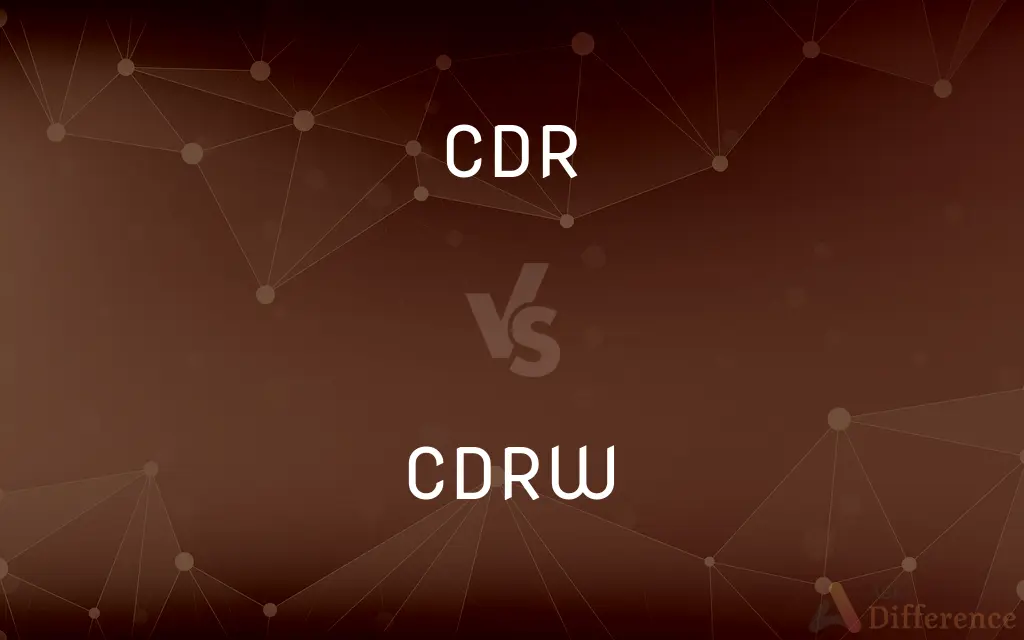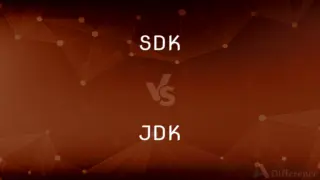CDR vs. CDRW — What's the Difference?
By Tayyaba Rehman — Published on December 31, 2023
CDR (Compact Disc Recordable) is a write-once optical disc, while CDRW (Compact Disc ReWritable) allows multiple write and erase cycles. Both store digital data.

Difference Between CDR and CDRW
Table of Contents
ADVERTISEMENT
Key Differences
CDR, standing for Compact Disc Recordable, offers users the ability to write data onto the disc once. After data has been written on a CDR, it becomes permanent and cannot be altered or erased. This characteristic of CDRs ensures that the stored data remains unchanged, making it a reliable medium for long-term storage. On the contrary, CDRWs, denoting Compact Disc ReWritable, provide flexibility in data storage.
CDRWs differentiate from CDRs in their capacity to be written over multiple times. This means that data stored on a CDRW can be erased and replaced with new information. This flexibility can be advantageous for tasks requiring iterative data updates or for users who need temporary storage. However, the ability to overwrite on CDRWs also introduces the possibility of data loss or unintentional modifications.
When considering the longevity and stability of the two types, CDRs often have the edge. Given that data on a CDR is permanent, it generally lasts longer and is less susceptible to degradation over time. CDRWs, due to their rewritable nature, might deteriorate faster, especially with frequent write and erase cycles.
In terms of cost, traditionally, CDRs were more affordable than CDRWs. This made CDRs a preferable choice for distributing data, like software or music, to a vast audience. CDRWs, with their rewritable feature, were often priced higher but offered more versatility for personal or business use.
Compatibility is another distinguishing factor. Some older CD players or drives might play CDRs effortlessly but struggle with CDRWs. This is due to the different ways data is written and read on these discs, requiring specific laser calibrations.
ADVERTISEMENT
Comparison Chart
Definition
Write-once optical disc.
Optical disc that can be written and rewritten.
Rewritability
Cannot be rewritten or erased.
Can be rewritten multiple times.
Longevity
Generally lasts longer and is stable.
Might deteriorate with frequent rewrites.
Cost
Traditionally cheaper.
Priced higher due to rewritable feature.
Compatibility
More widely compatible with older CD players and drives.
Might have issues with some older players and drives.
Compare with Definitions
CDR
Ensures data remains unchanged.
CDR is an ideal choice for legal documents due to its permanence.
CDRW
Generally pricier than CDRs.
CDRWs cost a bit more, but their versatility justifies the price.
CDR
An optical disc allowing one-time data writing.
Once I save my photos on this CDR, I can't delete or change them.
CDRW
Optical disc allowing multiple write-erase cycles.
I use CDRWs for projects as I can constantly update my files.
CDR
Often used for mass data distribution.
The company sent software updates on CDRs to all their clients.
CDRW
Can be overwritten with new information.
Don't worry about mistakes; we can always rewrite this CDRW.
CDR
Reliable for permanent data storage.
For archiving, I always choose CDR over other options.
CDRW
Suitable for temporary or iterative data storage.
For my draft works, a CDRW is my go-to storage medium.
CDR
Incompatible with rewriting or erasing data.
Ensure you have all files ready before burning them onto a CDR.
CDRW
Might face compatibility issues with older drives.
Check if your CD player supports CDRW playback before using it.
Common Curiosities
What does CDR stand for?
CDR stands for Compact Disc Recordable.
And CDRW?
CDRW stands for Compact Disc ReWritable.
Can I erase data from a CDR?
No, once data is written on a CDR, it's permanent.
How many times can I rewrite a CDRW?
A CDRW can typically be rewritten around 1,000 times.
Which one is more durable?
CDRs generally have better longevity than CDRWs.
Do they look different?
They look similar, but their labeling and packaging indicate their type.
Are CDRWs costlier than CDRs?
Traditionally, CDRWs were priced higher than CDRs.
Why might someone prefer a CDR?
For permanent, unchangeable storage, a CDR is preferable.
How much data can I store on these discs?
Both typically hold around 700MB, though variations exist.
Can all CD players read CDRWs?
Some older CD players might struggle with CDRWs but can read CDRs.
Is one better for audio or music?
Both can store audio, but CDRs are more commonly used for music distribution.
Are they still popular?
With USBs and cloud storage, their popularity has declined but they're still used for certain applications.
Can I use a CDRW as a backup option?
Yes, but frequent rewrites might reduce its lifespan.
How do I know if my device supports CDRW playback?
Check the device's manual or specifications for compatibility.
Are there brands better for CDR or CDRW?
Several reputable brands produce quality CDRs and CDRWs; reviews can offer insights.
Share Your Discovery

Previous Comparison
SDK vs. JDK
Next Comparison
Central Time vs. Pacific TimeAuthor Spotlight
Written by
Tayyaba RehmanTayyaba Rehman is a distinguished writer, currently serving as a primary contributor to askdifference.com. As a researcher in semantics and etymology, Tayyaba's passion for the complexity of languages and their distinctions has found a perfect home on the platform. Tayyaba delves into the intricacies of language, distinguishing between commonly confused words and phrases, thereby providing clarity for readers worldwide.
















































